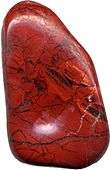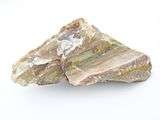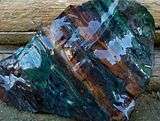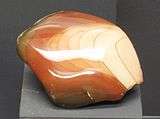Jasper
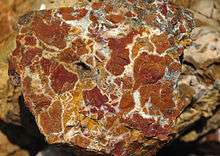
Jasper, an aggregate of microgranular quartz and/or chalcedony and other mineral phases,[1][2] is an opaque,[3] impure variety of silica, usually red, yellow, brown or green in color; and rarely blue. The common red color is due to iron(III) inclusions. The mineral aggregate breaks with a smooth surface and is used for ornamentation or as a gemstone. It can be highly polished and is used for vases, seals, and snuff boxes. The specific gravity of jasper is typically 2.5 to 2.9.[4] Along with heliotrope (bloodstone), jasper (green with red spots) is one of the traditional birthstones for March. Jaspilite is a banded iron formation rock that often has distinctive bands of jasper.
Etymology and history

.jpg)
The name means "spotted or speckled stone", and is derived via Old French jaspre (variant of Anglo-Norman jaspe) and Latin iaspidem (nom. iaspis)) from Greek ἴασπις iaspis, (feminine noun)[6] from an oriental language (cf. Hebrew יושפה yushphah, Akkadian yashupu).[7]
Green jasper was used to make bow drills in Mehrgarh between 4th and 5th millennium BC.[8] Jasper is known to have been a favorite gem in the ancient world; its name can be traced back in Arabic, Azerbaijani, Persian, Hebrew, Assyrian, Greek and Latin.[9] On Minoan Crete, jasper was carved to produce seals circa 1800 BC, as evidenced by archaeological recoveries at the palace of Knossos.[10]
Although the term jasper is now restricted to opaque quartz, the ancient iaspis was a stone of considerable translucency including nephrite.[2] The jasper of antiquity was in many cases distinctly green, for it is often compared to the emerald and other green objects. Jasper is referred to in the Nibelungenlied as being clear and green. The jasper of the ancients probably included stones which would now be classed as chalcedony, and the emerald-like jasper may have been akin to the modern chrysoprase. The Hebrew word yushphah may have designated a green jasper.[11] Flinders Petrie suggested that the odem, the first stone on the High Priest's breastplate, was a red jasper, whilst tarshish, the tenth stone, may have been a yellow jasper.[12]
Types
Jasper is an opaque rock of virtually any color stemming from the mineral content of the original sediments or ash. Patterns arise during the consolidation process forming flow and depositional patterns in the original silica rich sediment or volcanic ash. Hydrothermal circulation is generally thought to be required in the formation of jasper.
Jasper can be modified by the diffusion of minerals along discontinuities providing the appearance of vegetative growth, i.e., dendritic. The original materials are often fractured and/or distorted, after deposition, into diverse patterns, which are later filled in with other colorful minerals. Weathering, with time, will create intensely colored superficial rinds.
The classification and naming of jasper varieties presents a challenge.[13] Terms attributed to various well-defined materials includes the geographic locality where it is found, sometimes quite restricted such as "Bruneau" (a canyon) and "Lahontan" (a lake), rivers and even individual mountains; many are fanciful, such as "forest fire" or "rainbow", while others are descriptive, such as "autumn" or "porcelain". A few are designated by the place of origin such as a brown Egyptian or red African.
Picture jaspers exhibit combinations of patterns (such as banding from flow or depositional patterns (from water or wind), dendritic or color variations) resulting in what appear to be scenes or images (on a cut section). Diffusion from a center produces a distinctive orbicular appearance, i.e., leopard skin jasper, or linear banding from a fracture as seen in leisegang jasper. Healed, fragmented rock produces brecciated (broken) jasper. While these "picture jaspers" can be found all over the world, specific colors or patterns are unique, based upon the geographic region from which they originate. Oregon's Biggs jasper, and Bruneau jasper from Bruneau Canyon near the Bruneau River in Idaho are known as particularly fine examples. Other examples can be seen at Llanddwyn Island in Wales.[14]
The term basanite has occasionally been used to refer to a variety of jasper, a black flinty or cherty jasper found in several New England states of the US. Such varieties of jasper are also informally known as lydian stone or lydite and have been used as touchstones in testing the purity of precious metal alloys.[15]
Gallery
| Varieties of jasper | ||||||||||||
|---|---|---|---|---|---|---|---|---|---|---|---|---|
|
See also
References
- ↑ "U.S. Geological Survey, Chalcedony Site". www.USGS.gov.
- 1 2 Kostov, R. I. 2010. Review on the mineralogical systematics of jasper and related rocks. – Archaeometry Workshop, 7, 3, 209-213. PDF
- ↑ "Jasper". Mindat.org.
- ↑ Dietrich, R. V. (2005-05-23). "Jasper". GemRocks. Central Michigan University.
- ↑ "Finger Ring with a Representation of Ptah". The Walters Art Museum.
- ↑ "Strong's G2393-iaspis". Lexicon. Blue Letter Bible.
- ↑ "Jasper" at etymonline.com
- ↑ Kulke, Hermann; Rothermund, Dietmar (2004). A History of India. Routledge. p. 22. ISBN 0-415-32920-5.
- ↑ "Jasper". Gem by Gem. International Colored Gemstone Association.
- ↑ Hogan, C. Michael (2008-04-14). "Knossos fieldnotes". The Modern Antiquarian.
- ↑
 One or more of the preceding sentences incorporates text from a publication now in the public domain: Frederick William Rudler (1911). "Jasper". In Chisholm, Hugh. Encyclopædia Britannica (11th ed.). Cambridge University Press.
One or more of the preceding sentences incorporates text from a publication now in the public domain: Frederick William Rudler (1911). "Jasper". In Chisholm, Hugh. Encyclopædia Britannica (11th ed.). Cambridge University Press. - ↑ Hastings's Dict. Bible, 1902, as cited in 1911 Britannica.
- ↑ "World of Jaspers". Hans Gamma.
- ↑ Jasper Gemological Information - International Gem Society (IGS) Retrieved 16 January 2015
- ↑ "Mindat data for basanite". Mindat.org. 2012-10-15. Retrieved 2013-03-24.
External links
| Wikimedia Commons has media related to Jasper. |
-
 "Jasper". Encyclopedia Americana. 1920.
"Jasper". Encyclopedia Americana. 1920.
